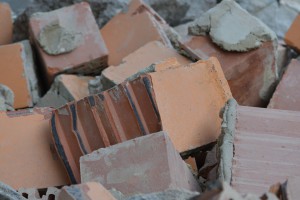Pre-demolition audit
Contents |
[edit] Definition
The document "Building Blocks; a manifesto to transform the Built Environment" published by Architects Declare defines a pre-demolition audit as
"a survey carried out by qualified personnel to determine the quantity of material in a building before its demolition or deconstruction. It helps to identify materials within the building that could be reused or repurposed."
[edit] Introduction
It’s always best, when considering demolishing a building, to ask certain questions before beginning any work – even planning work. The first, and perhaps the biggest, is to ask why you want to demolish the existing site – can it be redeveloped or can elements of the site be kept?
A pre-demolition audit can help answer these questions, along with assessing the materials within the buildings and their potential value. When you have all of this information, that’s when you need to look at whether to refurbish, renovate or demolish.
[edit] So, you have decided to demolish
What will you be doing with all of those materials? Best practice says you should try to reclaim as much waste as possible, and there are four key ways to handle demolition waste reclamation, known as the Four R’s – each with their own advantages:
[edit] Reduce
Are there any areas of the building you can keep? Reducing the amount of waste through not demolishing a part of a building will help you to save time and money through sorting or transportation.
[edit] Reuse
What areas can be reused in their current form? Timber or metal beams, intact fireplaces, heating or electrical systems? If these, and more, can be reused in the new building on the same site, this will help you save on some new build materials cost and will reduce time spent recycling or disposing of materials, saving time in the process.
[edit] Recycle
When materials on your site can’t be reused, can they be recycled? This is taking the materials and using them in a different form, for example taking a timber beam and shredding this, to reform into MDF or a similar material – for use in the new building.
[edit] Recover
This option is often best for teams that aren’t able to go through options 1-3, for example if there’s little time to complete these activities. Recovering materials in essence a means to send all mixed (unsorted) waste materials to a facility, where they will look to reuse or recycle them externally.
The more material that can be dealt with using a mixture of the above options, the greater the chance of saving money through on build costs, selling materials that have been identified as having value, or even just avoiding landfill tax.
This article was created by --BRE Buzz. It was originally published on BRE Buzz in March 2016 and was written by Jo Goodwin, Marketing Manager for BRE SMARTWaste and BRE YellowJacket.
You can see the original article here.
Read more BRE Buzz articles here.
[edit] Related articles on Designing Buildings
- Building Research Establishment.
- BRE articles.
- BRE Trust.
- BREEAM.
- Decommissioning.
- Demolition.
- Design for deconstruction – helping construction unlock the benefits of the circular economy.
- End of life potential.
- Explosives.
- How to conduct a pre-demolition audit.
- Pre-construction information.
- Quantification of construction materials in existing buildings (material intensity).
- Recycling.
- Site waste management plan.
- Sustainable materials.
Featured articles and news
The UK’s largest air pollution campaign.
Future Homes Standard, now includes solar, but what else?
Will the new standard, due to in the Autumn, go far enough in terms of performance ?
BSRIA Briefing: Cleaner Air, Better tomorrow
A look back at issues relating to inside and outside air quality, discussed during the BSRIA briefing in 2023.
Restoring Abbotsford's hothouse
Bringing the writer Walter Scott's garden to life.
Reflections on the spending review with CIAT.
Retired firefighter cycles world to raise Grenfell funds
Leaving on 14 June 2025 Stephen will raise money for youth and schools through the Grenfell Foundation.
Key points for construction at a glance with industry reactions.
Functionality, visibility and sustainability
The simpler approach to specification.
Architects, architecture, buildings, and inspiration in film
The close ties between makers and the movies, with our long list of suggested viewing.
SELECT three-point plan for action issued to MSPs
Call for Scottish regulation, green skills and recognition of electrotechnical industry as part of a manifesto for Scottish Parliamentary elections.
UCEM becomes the University of the Built Environment
Major milestone in its 106-year history, follows recent merger with London School of Architecture (LSE).
Professional practical experience for Architects in training
The long process to transform the nature of education and professional practical experience in the Architecture profession following recent reports.
A people-first approach to retrofit
Moving away from the destructive paradigm of fabric-first.
International Electrician Day, 10 June 2025
Celebrating the role of electrical engineers from André-Marie Amperè, today and for the future.
New guide for clients launched at Houses of Parliament
'There has never been a more important time for clients to step up and ...ask the right questions'
The impact of recycled slate tiles
Innovation across the decades.
EPC changes for existing buildings
Changes and their context as the new RdSAP methodology comes into use from 15 June.

























